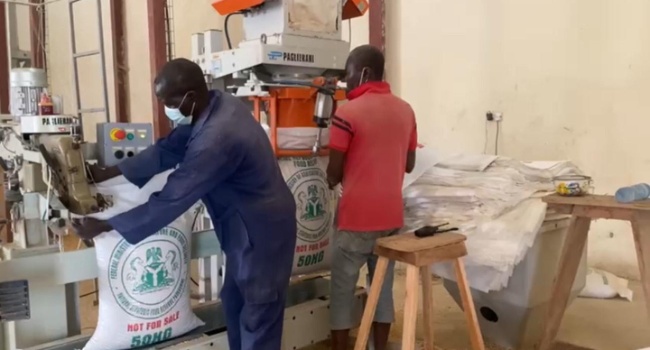The presidency says the ministry of agriculture and food security is in the final stages of releasing 42,000 metric tonnes (MT) of assorted food commodities to support vulnerable Nigerians.
Bayo Onanuga, special adviser to the president on information and strategy, made this known in a statement on Friday.
Onanuga said the grains, in seven locations of strategic reserve, are currently being bagged for onward delivery to the National Emergency Management Agency (NEMA).
“The need to bag the grains, caused the delay as the bags were freshly ordered by government,” he said.
Advertisement
“Nigerians will not need to pay for the grain bags, as they are free. This will be complemented by the 60,000 metric tonnes of milled rice to be purchased by the Federal Government from the Mega Rice Millers.”
Speaking on the issue, Abubakar Kyari, minister of agriculture, said the announcement of the impending releases of food commodities from the strategic reserve has resulted in a significant drop in commodity prices throughout the country’s major grain markets.
‘FG RAMPING UP FOOD PRODUCTION’
Advertisement
Also, Onanuga said the federal government is ramping up food production by boosting dry season farming under the National Agricultural Growth Scheme Agro-Pocket (NAGS-AP) project.
The first phase of the dry season farming, the statement noted, was launched in November 2023.
According to the government, the focus will be on the cultivation of wheat across 15 wheat-producing states, spanning 118,657 hectares and involving 107,429 farmers.
Abubakar Kyari, minister of agriculture, said the fields are green and harvest will commence in a matter of weeks.
Advertisement
“There are fantastic reports of growth of wheat from Jigawa State, which is now targeting harvest from about 50,000 hectares, 10,000 hectares more than initially allotted under the programme,” Kyari said.
Phase 2 of the dry season farming, covering rice, maize, and cassava, is also expected to commence soon across all 36 states of Nigeria and the federal capital territory (FCT).
“For rice, the target is 250,000 hectares involving 500,000 farmers with the expected output of 1 million metric tons of paddy rice,” the minister said.
“For maize, we are cultivating 55,000 hectares with 110,000 farmers thereby adding 165,000 metric tons to national maize production while for cassava, we are doing 35,000 hectares with 70,000 farmers to produce 525,000 metric tons of cassava.
Advertisement
“The NAGS-AP Project offers a 50% subsidy. However, the Federal Government is providing additional support for Phase 2, which will bring aggregate subsidy to about 93 % to farmers cultivating the crops.
“Also various governors are showing strong support, to further enhance the subsidy.”
Advertisement
In addition, solar-powered water pumps for irrigation, provided by the federal government, are also being deployed to aid the next phase of the programme.
Advertisement
Add a comment






